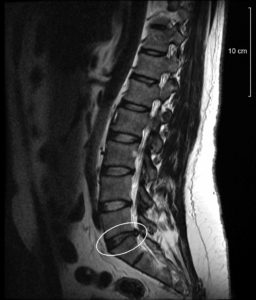What is a “slipped disc” and can Chiropractic help?
We have 24 vertebrae in our spine and between each one (with the exception of the top 2 in the neck) there is a disc. Discs act as

Imagine if you jump up and down. What would happen to the stack of bony vertebrae that make up the spine without the cushioning and support of these discs? Now, move your back from side to side. Again, you can visualize the give and take of the discs between the vertebrae. Without these discs, the spine wouldn’t be able to function.
Discs are so strong they do not slip. “slipped disc” has become a popular phrase that refers to bulging, ruptured, or herniated discs. Since the correct term is herniated disc, that is what we’ll use. General symptoms of a herniated disc are pain, pain with sneezing or coughing, shooting pains and or numbness and tingling into either the arms/fingers (if cervical) or down the legs (if lower back)
Your discs are made up of a tough outer layer and a soft gel-like center. Cracks can occur in the outer layer of the disc causing the soft gel to get pushed out. There are many factors that may cause a disc to herniate but there isn’t consensus as to one reason or other. Some studies show sedentary lifestyles, as a cause. While others attribute disc herniations to repetitive strenuous jobs/activities and excess weight.
Chiropractic is a non-invasive (non-surgical) and conservative treatment option. Your xrays, MRIs (if any were ordered) will be looked at along with things such as loss of muscle strength, loss of sensation along a nerve path and reflexes such as tapping against your knees with a small hammer to see if your knees jerks up.
One of the best Chiropractic treatments for herniated discs is a technique called Flexion-Distraction Technique. Flexion-distraction involves the use of a specialized table that gently “distracts” or stretches the spine. This allows for isolation of the affected area while slightly “flexing” the spine using a pumping rhythm. The gentle pumping action allows for the gel like center to resume its position in the center of the disc.
This technique can help move the disc away from the nerve, reducing inflammation of the nerve root, and eventually any associated pain and inflammation into the leg.
With flexion-distraction, you generally need a series of treatments combined with adjunctive ultrasound, muscle stimulation, physiotherapy, supplementation, and at-home treatments.
In the meantime, what can be done to minimize the risks of a disc herniation?
Staying fit through a regular exercise program that includes flexibility and stretching routines, maintaining a healthy diet and learning proper lifting techniques, such as bending with your knees to pick up heavy objects and lifting them close to your body.
